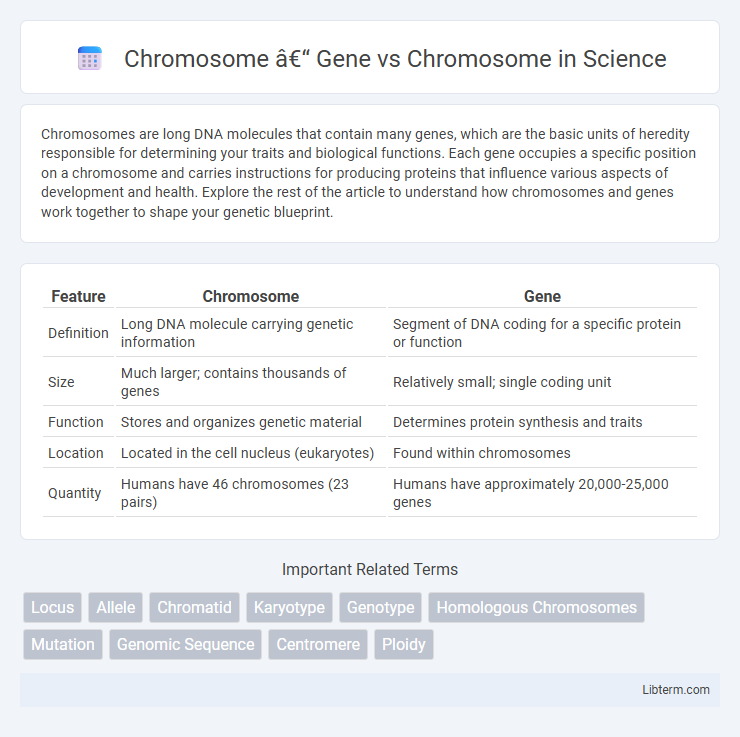Chromosomes are long DNA molecules that contain many genes, which are the basic units of heredity responsible for determining your traits and biological functions. Each gene occupies a specific position on a chromosome and carries instructions for producing proteins that influence various aspects of development and health. Explore the rest of the article to understand how chromosomes and genes work together to shape your genetic blueprint.
Table of Comparison
| Feature | Chromosome | Gene |
|---|---|---|
| Definition | Long DNA molecule carrying genetic information | Segment of DNA coding for a specific protein or function |
| Size | Much larger; contains thousands of genes | Relatively small; single coding unit |
| Function | Stores and organizes genetic material | Determines protein synthesis and traits |
| Location | Located in the cell nucleus (eukaryotes) | Found within chromosomes |
| Quantity | Humans have 46 chromosomes (23 pairs) | Humans have approximately 20,000-25,000 genes |
Introduction to Chromosomes and Genes
Chromosomes are thread-like structures composed of DNA and proteins, housing thousands of genes that serve as the fundamental units of heredity. Genes located on chromosomes encode instructions for synthesizing proteins, which determine an organism's traits and biological functions. Understanding the relationship between chromosomes and genes is essential for studying genetic inheritance, variation, and molecular biology.
Defining Chromosomes: Structure and Function
Chromosomes are thread-like structures composed of DNA and proteins, primarily histones, that organize genetic material within the cell nucleus. Each chromosome carries many genes, which are specific sequences of nucleotides encoding hereditary information essential for cell function and development. The structure of chromosomes, including the centromere and telomeres, ensures accurate DNA replication and distribution during cell division, maintaining genetic stability.
What Are Genes? Roles and Characteristics
Genes are specific sequences of DNA located on chromosomes that serve as the fundamental units of heredity, encoding instructions for the synthesis of proteins essential for cellular function. Each chromosome contains thousands of genes arranged linearly, influencing traits and biological processes through their expression. Genes have distinct characteristics such as variability in size, the ability to undergo mutations, and regulation that determines when, where, and how much protein is produced.
Chromosome vs Gene: Key Differences
Chromosomes are large DNA molecules that contain multiple genes, which are specific sequences of nucleotides encoding proteins or functional RNA. Each chromosome serves as a structural unit organizing genes, while genes act as functional units responsible for heredity and biological traits. The key difference lies in scale and function: chromosomes house many genes and ensure proper DNA replication and segregation, whereas genes direct the synthesis of proteins that determine phenotypic characteristics.
How Genes Are Organized on Chromosomes
Genes are segments of DNA organized linearly along chromosomes, each occupying a specific position called a locus. Chromosomes contain both coding regions (genes) and non-coding sequences, arranged in a precise order that facilitates gene regulation and expression. The structural organization ensures that genes are inherited as units during cell division, maintaining genetic continuity across generations.
Genetic Inheritance: Genes and Chromosomes Explained
Genes are specific sequences of DNA located on chromosomes that serve as the fundamental units of genetic inheritance, determining traits passed from parents to offspring. Each human cell typically contains 23 pairs of chromosomes, which house thousands of genes encoding proteins essential for development and function. Chromosomes ensure the accurate replication and distribution of genes during cell division, enabling the consistent transmission of hereditary information across generations.
Chromosomal Disorders vs Gene Mutations
Chromosomal disorders arise from structural changes or numerical abnormalities in entire chromosomes, such as deletions, duplications, or aneuploidy, leading to conditions like Down syndrome or Turner syndrome. Gene mutations involve alterations at the DNA sequence level within specific genes, causing diseases such as cystic fibrosis or sickle cell anemia. Understanding the distinction between chromosomal abnormalities and gene mutations is crucial for accurate diagnosis, genetic counseling, and therapeutic strategies.
The Central Dogma: From Genes to Proteins
Chromosomes are long DNA molecules containing numerous genes, each encoding specific proteins essential for cellular functions. The Central Dogma of molecular biology describes the flow of genetic information from DNA (genes) within chromosomes, through transcription into messenger RNA, and translation into proteins that determine phenotypic traits. Understanding the relationship between genes and chromosomes is crucial for studying gene expression regulation, mutations, and genetic disorders.
Advances in Genomic Research: Genes and Chromosomes
Advances in genomic research have illuminated the intricate relationship between genes and chromosomes, revealing that chromosomes are long DNA molecules containing numerous genes, which serve as functional units of heredity. High-resolution sequencing technologies enable precise mapping of genes along chromosomes, facilitating breakthroughs in identifying gene functions, mutations, and their roles in complex diseases. Cutting-edge techniques such as CRISPR and chromosome conformation capture have deepened understanding of chromosomal architecture and gene regulation, accelerating personalized medicine and genomic therapies.
Summary: The Relationship Between Genes and Chromosomes
Genes are specific sequences of DNA located on chromosomes, which serve as the structural units carrying genetic information within cells. Each chromosome contains many genes that determine inherited traits by encoding proteins or functional RNA. Understanding the relationship between genes and chromosomes is essential for studying genetic inheritance, mutation, and molecular biology.
Chromosome – Gene Infographic

 libterm.com
libterm.com